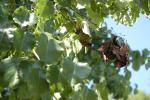COLUMBIA, Mo. – University of Missouri Extension regional horticulture specialist James Quinn said tomatoes are a good choice for gardeners using a high tunnel for the first time. Quinn spoke about high tunnels at a recent workshop at MU’s Bradford Research and Extension Center.
Before planting, producers should have the soil tested, work the soil by adding compost and fertilizer, and determine spacing for planting, Quinn said. Most producers prefer spacing plants 2-4 feet apart.
Planting may begin as early as March 22 in Missouri’s central region. If using supplemental heat, planting can be as early as February. He recommends fertilizing plants with a diluted solution immediately after planting. Plants can be protected with row covers, as required, until flowering. Growers should follow a fertilizing schedule and sucker prune (pinch back) side shoots for earlier fruit.
For beginners, Quinn recommends determinate tomatoes, which bear their crop in a four- to six-week period. Indeterminate tomatoes, which bear fruit over the course of the season, grow longer vines that generally require more time and technique to support.
Trust, Big Beef and Goliath are popular varieties that require training.
Yields can vary from 10 to 20 pounds per plant. Most determinates will yield 15 pounds per plant, Quinn said. Tomatoes sell for $1.50 to $2 per pound in many Missouri markets.
The earlier start provided by high tunnels means tomato plants begin bearing fruit in May or early June. A second crop of tomatoes can grow in the late fall, but yield will be about 40 percent less and supplemental heat may be needed.
Quinn recommends that growers tear their tomato plants out of the high tunnels when done with picking and plant a cover crop. A mix of buckwheat, oats and soybeans is a good low-cost option.
For more information on high tunnels, go to www.extension.missouri.edu and enter “high tunnels” in the search box.
Information about high tunnel research is also available at www.hightunnels.org, a joint effort of MU Extension, Kansas State Research and Extension, and University of Nebraska Cooperative Extension.
Read more http://extension.missouri.edu/news/DisplayStory.aspx?N=1702





